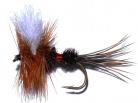Saltwater Fly Lines floating wf
Customer Reviews
This product hasn't been reviewed yet. Write a review
- About Us
- The Ultimate Snowy Mountains Spawn Run Combo: Flies + Strike Indicators
- Mike’s Hatch Picks – September & October Start of the Season • TroutFlies Australia By Mike Tenner
- The Best Fly Patterns for Australian Waters: Proven Winners by TroutFlies Australia
- Tasmania New Season 2025 , Fresh Water, and Fresh Chances
- Top Nymph Patterns That Work in Aussie Waters
- Beginner’s Guide to Buying a Fly Rod for Saltwater and Freshwater Fishing By Mike Tenner – Fly Fishing Guide with Over 50 Years’ Experience
- 10 Common Fly Fishing Fly Mistakes: What Fly to Use and When (And How to Fix Them)
- Reading the Water: How to Identify Trout-Holding Lies in Rivers and Lakes
- What, Why, and When: Choosing the Right Fly Line in 2025
- Matching the Hatch in Australia: A Local Insect-to-Fly Guide
- The Complete Guide to Fly Fishing Leaders and Tippet: What to Use, When, and Why
- The Hidden Science of Fly Colour: How Trout Really See Your Flies
- Hooked on Health: The Surprising Wellness Benefits of Fly Fishing
- New to Fly Fishing? We've Got Your Back at TroutFlies Australia
- Transitioning from Trout to Saltwater Fly Fishing: Your Complete Australian Guide
- How Carp Took Over Australian Rivers—and Why Fly Fishers Are Fighting Back
- Finding the Feeding Zone: Why Trout Aren’t Always on Top or Bottom During Hatch
- Must-Have Knots for Fly Fishers: The Essential Guide
- The Best Fly Fishing Flies for Australian Waters (2025 Guide)
- Best Seasons for Fly Fishing in Australia: A Complete Guide By Mike Tenner
- Fly Fishing Gear Checklist: What to Pack for a Successful Trip
- The Hidden Science Behind Fly Patterns: Why Certain Flies Outfish Others in Australian Waters
- Targeting Big Brown Trout: Techniques for Catching the Smartest Fish in the River
- Top 5 Trout Flies for Autumn in Australia
- The Ultimate Guide to Fly Fishing in Australia: Tips, Techniques & Best Spots
- Top 10 Mistakes Beginners Make in Fly Fishing (And How to Avoid Them)
- Guide to tell the difference between the fly types
- The Art of Presentation in Fly Fishing: More Than Just Casting a Line
- 10 Must-Have Trout Flies for Every Australian Angler: A Seasonal Guide
- Top 5 Trout Flies Every Australian Angler Needs in 2025
- Mastering Fly Fishing in Australia: Top Spots, Tips, and Gear
- Nano or Not? Choosing the Right Fly Rod for Your Fishing Adventures
- What is Fly Fishing
- Unveiling the Secrets of Fly Fishing Success in Australia
- Saltwater Fly Fishing Down Under: This is Going to Be Your New Obsession
- 9 Essential Gears for Saltwater Fly Fishing
- A Beginner's Guide to Saltwater Fly Fishing - Everything You Need to Know
- Best Saltwater Fly Fishing Destinations in Australia
- The Fly Fishing Fly Guide: A List Of The Best Fly Fishing Flies
- Fly Fishing In Tasmania: Your Travel Guide
- The Beginner's Guide To Fly Fishing
- Newsletter
- Help
- Shipping,Customer Service,Terms & Conditions
- Privacy Policy
- Sitemap
- Contact Us











